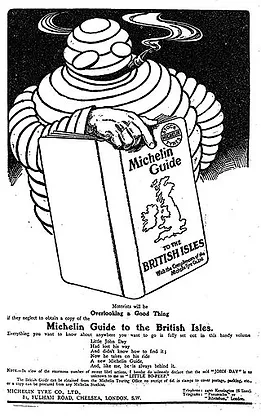What is content marketing and how can you use it to grow your business?
Content marketing is the creation, publishing, and promoting content that aims to inform, educate, and entertain your audience. The goal of content marketing is to both get your product, service and/or brand in front of the eyes of large audiences, as well as, creating a meaningful, entertaining, and informative presence online by offering value and insight.

Content marketing may have turned into a buzzword in the past ten years, but in reality, content marketing has been around for over a century. One of the best and most well known examples is the Michelin Travel Guide, which spawned the accolade ‘Michelin Star’. French Tyre manufacturer Michelin published the first Michelin Travel Guide in 1900 to encourage people to travel more and thus, buy more tyres. They rated restaurants with a star-system and the success of the guides meant that eventually the Michelin Star was one of the most-coveted culinary honour your eatery could get.
Fast forward to today, and content marketing is just as effective (and easier) than ever. Customers no longer want their online activities to be interrupted by in-your-face, obnoxious advertisements. This is where content marketing comes in, as it plays a more natural role in the marketing world. Effective content marketing gets your business in the minds of customers without making them feel as though ads are being forced on them. No matter what kind of business you are, B2B or B2C, this form of marketing gives you the chance to naturally engage with your potential customers, existing clients, and anyone online.
You have the opportunity to transform your company from a profit-driven business to a personable, fun, and entertaining brand. Brands must remember that it is no longer the final sale that brings the most value, but the lasting relationships you build with your customers.
Content that works
1. BLOGS
You may have already guessed it, but blogs are a key form of content marketing most, if not all, businesses should be producing. Blogs are crucial for several reasons, and we’re here to tell you why.
Producing blogs that discuss topics that are relevant to your business and your industry gives you the advantage of becoming a thought leader in your area. Keeping your blogs specific to your expertise and services places you as an expert in your chosen field which, in the eyes of a customer, makes you more reliable to do business with.
Along with this, blogs are a staple type of content that improves your SEO. You have a much higher chance of appearing at the top of search engines, which in turn attracts more people to your site. A well-researched topic combined with effective use of keywords is the perfect combination for great SEO, resulting in lead generation and relationship building.
We here at pluto aim to share one blog a week that discusses one of our areas of expertise – digital and content marketing, shopper marketing, event management, and influencer marketing. It is a great way to share our learnings, achievements, and knowledge with our clients.
2. VIDEO
This style of content is more important than ever, especially with new video-creating apps being released every minute. Video is essential, as it can be tailored to promote anything – data, an event, a social media campaign, the list goes on. No matter what the brand or what you’re selling you can make video content work for you. Creating videos is a fantastic way of showing your onli
ne presence that you are a thought leader in your industry through demonstration videos, that you are reliable and trustworthy through informative videos, that you are personable through light-hearted videos, and that you care about your customers through emotional videos.
Video certainly requires more investment of time, resources, and skills, however, the ROI, the brand awareness, and the WOM (word of mouth) that can be achieved from a well-crafted video are definitely worth it. Videos are 40x more likely to be shared among customers than any other content form because it is content that is captivating. When we created a campaign for Dublin Rape Crisis Centre, we wanted to spread it’s message in a way that engaged. Video was the natural fit! Check it out below.
3. PODCASTS
Podcasts have seen a soar in listeners in recent years, and we can see why! They are a great form of content that can be listened to everywhere and anywhere. Whether you’re at the gym, out for a stroll, commuting, even cleaning your room, a podcast is the perfect entertainment!
It is without a doubt a bigger investment, however one worth thinking about. You might immediately think, but how can a podcast work for my service-providing B2B business? Podcasts don’t need to be confined to any one genre, they can be used to do so much more. For example, you can dedicate an episode to discussing the new, emerging trends in your industry, and another episode interviewing a key person in your industry! This style of content is guaranteed an interesting listen for your clients and other businesses in your industry, as well as people with an interest in what you do and sell.
Some big brands have made successful branded podcasts to bring exposure to there brand and provide their audience with valuable information, insight and entertainment, for instance Sephora’s “#LIPSTORIES” podcast and Microsofts “.future” podcast.
4. CASE STUDIES
Case studies are a terrific way to tell a story. Whether that story is a successful event, an impressive campaign, an outstanding digital campaign, or a lovely customer success story.
This style of content aims to position your brand in a way that places faith in a customer’s mind when they are considering taking up business with you. Having a bank of real-life examples shows customers that you know what you’re doing and builds trust.
At pluto, we produce a case study for all of our events. We use this style of content to show the life-cycle of our work – the task we faced, the clients desired results, and show how we transformed this idea into a finished product. It allows our readers to truly see our thought process, our problem-solving skills, and how we use our creativity to create the finished result. We believe giving customers this look into our client’s journey and providing real results/data is a great way to build a solid relationship from the very beginning.
At Pluto, we love creating videos, so after each of our campaigns, we put together a short 30-second video. The goal here is to highlight how the campaign did and display it in a way that is easy to digest and understand for our audience. This way our campaign results become more engaging and memorable.
5. INFOGRAPHICS
You have too much data, too much to say, and don’t want to produce word-heavy content no one has time to read? Infographics are your pal!
Infographics give you the opportunity to transform regular data into more compelling, creative and colourful visuals that are easier for people to read and also much more memorable. They are easier to understand, cost effective and captivating. There are also plenty of tools online that can help you when starting off, such as, Canva.
6. E-BOOKS
Ebooks are a much longer form of content, however, gives you the chance to go much more in-depth with your knowledge and information about a topic.
When creating an ebook, your focus is purely on the content and not the captivating and engaging factor of the content. This is because those who choose to opt into your ebook are already engaged – they wouldn’t have signed up to it if they didn’t plan on reading it. Ebooks are also great data collecting sources, as customers sign-up using their names and email addresses – perfect for lead generation and retargeting! As long as you keep your ebook concise and educational, the ROI is great for businesses!
7. SOCIAL
You can use social media accounts a number of ways. Not only can you create fun, eye-catching product-focused creatives to fill up your feed, you can use all your socials to cross promote your other content. Use your channels to amplify the reach of all the other content you’re producing (all of the above content forms) and get sharing!
Repurpose your content, create Instagram stories to attract people to your website to read your blogs and case studies, link your podcast in your bio, post about your newest ebook on your Facebook page – use that cross-promotional strategy to your advantage!
To the right you can see how we promoted our Pride Blog on our Instagram feed. We created a short, colourful feed post to encourage our followers to visit our website and read our blog.
What is the most effective form of content?
When it comes to content marketing, one size does not fit all. Although it’s important to use different formats and mix it up, what performs well for you may not perform the same for the next person. It is all about finding the right balance and the right style that fits your business and entertains your audience.
This involves tailoring and adjusting until you find your flow. If you find video content engages your audience more effectively than blogs, then focus your efforts there. This doesn’t mean throwing out the content you’ve written about in your blog, it just means taking that content and feeding it to your audience in a way that they enjoy taking in information. Switch it up – try an infographic or maybe discuss it on a podcast episode. We live in a world where 60-second videos can barely hold people’s attention, so make sure you’re tailoring your content to fit the needs of those you desire to attract.
The Golden Rule
Generally speaking – different audiences live on different platforms that suit different content styles. Something that works on Facebook won’t necessarily work on Instagram or Twitter. For example, sharing video and photo based content is what Instagram was made for, whereas Facebook and Twitter are great platforms for more conversational content. Create a content calendar that clearly specifies what goes where and when so you can keep organised.
And remember, your business might have one specific type of customer but that does not mean your content can only apply to that one audience. Your content, as long as it is relevant, entertaining and engaging, can be enjoyed by and be useful to anyone and everyone. Make people want to share your content with others.
Your competitor’s might be selling a similar service, but they can’t produce the content you’re sharing. So, stand out through your content starting now!






















